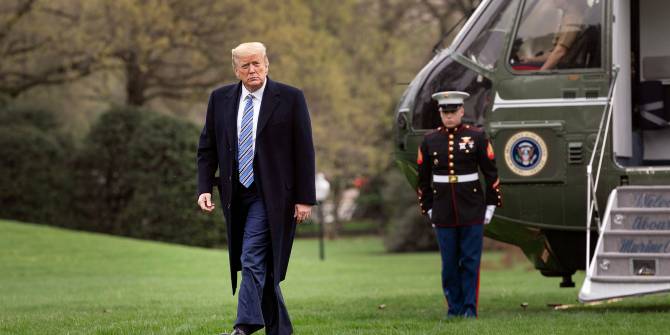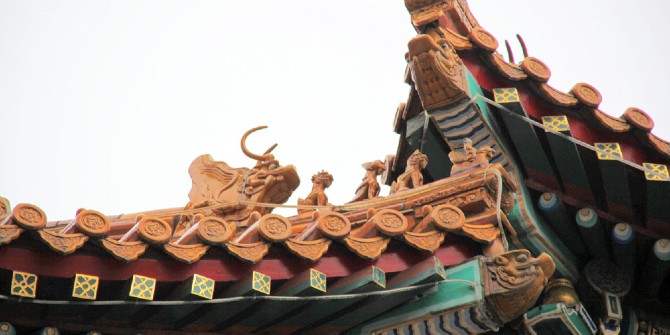The UK may end up with a no-deal, ‘WTO Brexit’. But the organisation is in urgent need of reform. Dariga Mukhamedina (LSE) explains how greater transparency would foster trust between WTO members.
A long time has passed since the GATT transformed into the biggest trade organisation in the world, and current events show that there has never been a greater need for an institution like the World Trade Organisation. Despite the failure of the Doha Round, the WTO contributed a lot to the global trade agenda, eliminating barriers and establishing regulations to facilitate trade. But in times of major crisis – both health and financial – we cannot ignore the challenges that the WTO faces. Does government intervention constitute unfair trade? Are states complying with existing trade norms? How can rules in areas like e-commerce be designed? In order to answer these questions, we need to know what the governments of WTO members are doing.
Why the need for transparency?

Transparency has always been an indissoluble part of the WTO, starting with GATT (1994) Article X which proclaimed it as a key element of the system, and so it is today in the WTO reform agenda. Transparency is front and centre in every dispute, whether it is over development, monitoring or implementation of the WTO rules. It often involves the enforcement of such measures as publication of trade regulations, notification obligations and the right of private traders to ask for an additional information through ‘inquiry points’.
One of the ‘living examples’ is a Trade Policy Review (TPR) mechanism, according to which WTO member states can ask questions of their peers during one of the regular reviews of an country trade policy. The TPR report is based on the questionnaires submitted by states, as well as on information from various international organisations, media sources and non-governmental institutions, gathered and checked by the WTO Secretariat (Mavroidis and Wolfe, 2015). Effective transparency reduces the asymmetry of information available to WTO members, which contributes to greater equality in the process of negotiation and in monitoring the actions of other WTO members. What is more, it plays an important role in the decision-making processes of the institution. First of all, transparency helps to monitor the compliance of states with various WTO agreements, which is challenging for every international organisation; the lack of transparency may reduce the effectiveness of these treaties, as well as mitigate its raison d’être. Secondly, it endorses the principle of ‘free and liberal trade’ by granting the WTO the external image of an open and transparent institute that provides an international public good. And last but not the least, transparency contributes to an atmosphere of trust and ensures the basis for negotiating reciprocal commitments which are critical for productive negotiations between WTO member states.
The main challenges
Even maintaining the existing level of transparency can be difficult for WTO members. Digitisation makes it easier, but some countries still find it difficult to submit notifications in a timely manner and therefore undermine overall compliance. As recent studies have shown, only 17 member states follow the requirements on transparency fully (100%) and about 31 countries have a compliance rate tending to zero (Ismail, 2020). The level of compliance also varies from sector to sector (for instance, notifications of industrial subsidies are poorer than for agriculture subsidies), and from member state to member state – some countries submit comprehensive reports, while others prefer to keep it short (Wolfe, 2013). Consequently, one of the main questions faced by the WTO is how to preserve compliance with all existing transparency obligations. Only after that can there be room for improvement.
Another challenge is the link between transparency and the controversy about development questions, in particular the criteria for the application of special and differential treatment to transparency. Since one of the reasons for non-compliance is the cost of notifications (notably the lack of resources and time), some countries ask to have full account taken of their capabilities and level of development. In practice, this results in disagreement among delegates about the criteria for providing financial support or other concessions. Apart from that, transparency can only be improved by reciprocal measures adopted by all the parties. If some countries make full submissions of notifications and others simply ignore the obligation to do so, there will be no progress. Given the key players cannot agree how to pursue WTO reform, deadlock has ensued.
The positions
Developed and developing economies are divided about how to use transparency to reform the WTO. Judging from papers recently submitted in the reform discussions by two coalitions of WTO members, developed states are more inclined to pursue the imposition of so-called ‘punitive measures’ for non-compliance with the notification requirements. However, the United States, the European Union, Japan and other participants in this coalition offer the carrot of financial support to those who are entitled to it, as well as waving the stick.
Developing states have responded with a counter proposal. India, South Africa and others pleaded for more a cooperative and inclusive approach in order to take account of their time and resources constraints. They have emphasised the need for a different kind of transparency – namely, with regard to the process of decision-making within the WTO – on the grounds that smaller and developing country members are often dominated by the major WTO members.
China, another vital player, has always held an exceptional position on transparency. On its accession in 2001 China agreed to specific commitments, including an official journal with comments, the Transitional Review Mechanism, translation obligations and others. Having made so many compromises in the past, China is cautious about accepting more. It also sees transparency demands as potentially the thin end of a wedge aimed at forcing China to choose between a rules-based trading system and its own model of development.
What to expect
All WTO members understand the need for the reform, as well as the importance of transparency as a cornerstone of the Organisation’s trading system. States also realise that it should be applied to all areas of the WTO and become integral to the trading system. In the meantime, improvement depends on the willingness of countries to work together in a pragmatic and constructive fashion. Transparency is in itself a public good, as well as a key building block of an open, rules-based trading system.
This post represents the views of the author and not those of the Brexit blog, nor LSE. It is the fourth in a series looking at the challenges facing the WTO; the first post is here. It draws on an extensive simulation of WTO reform as part of an LSE International Relations Department masters course option in economic diplomacy.
Sources
Ismail, F. (2020). WTO reform and the crisis of multilateralism: a developing country perspective. (ebook) pp.5-28, 39-79.
Mavroidis, P. and Wolfe, R. (2015). From Sunshine to a Common Agent. The Evolving Understanding of Transparency in the WTO. SSRN Electronic Journal, RSCAS Policy Paper 2015/01.
Wolfe, R., 2013. Letting The Sun Shine In At The WTO. Geneva: World Trade Organization, Economic Research and Statistics Div.





